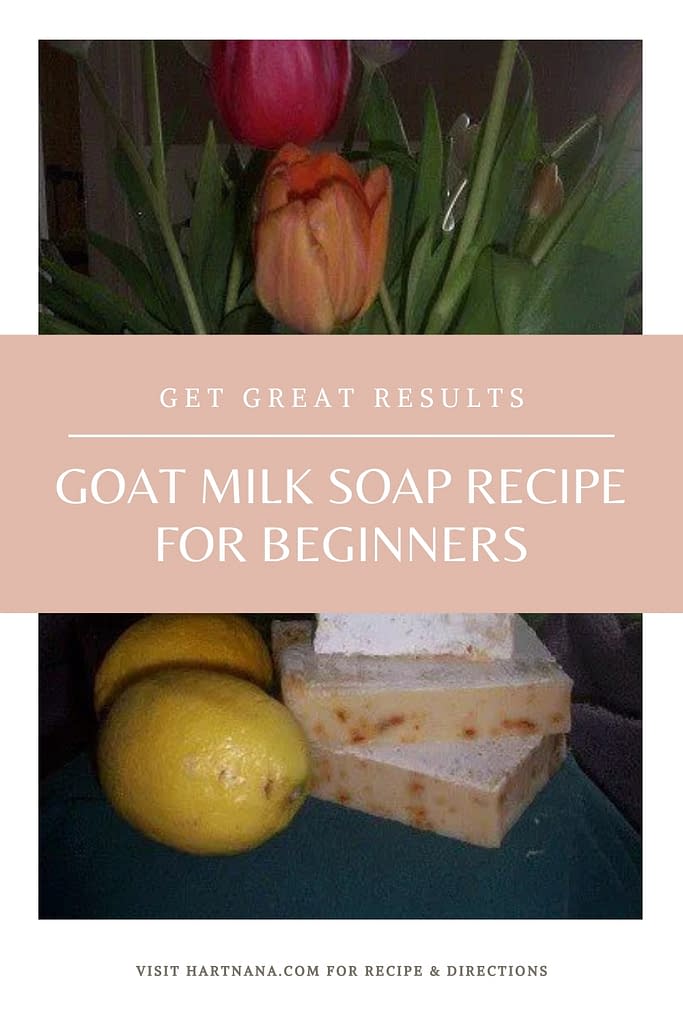
Having been a soap maker for quite a few years now, I have discovered this secret almost by accident and now make wonderfully luxurious cream colored goat’s milk soap. Using this secret disclosed in the homemade goat milk soap recipe for beginners, you will be making great soap for your family and friends too, with very little headache.
Easy To Find Ingredients
Most of these ingredients can be purchased at your local grocery or health food store, except for the lye (sodium hydroxide) that will need to come from an online source probably Amazon. You can get smaller quantities from them and it is shipped without hassle for a reasonable price. It is hard to keep 50 pounds of lye around if you aren’t making soap in large quantities. 50 Pounds is the quantity sold most commonly by soap maker supply companies.
What you need to make Goats Milk Soap For Beginners
As far as utensils go; it really depends on how much soap you plan to make. This recipe will make about three pounds of soap – enough to cover the bottom of a Campbell’s soup box (you know the cardboard that holds a case of soup). If you cut it in half then you could make 8 bars in soap molds.
I like to use an enamel pot that has high sides. I melt the solid oils together first over low, then add the olive oil so cool the oils down to 100degrees. And then when I mix the lye solution in I’m less likely to splash the mixture on myself. (Vinegar is the neutralizing agent for lye – keep it out and handy if you get some lye or lye mixture on you, douse with vinegar and it will stop the burning).
Though you may be tempted to make this without safety glasses, refrain. Wear those glasses! And gloves. Wear gloves.
Okay, enough on the safety warnings. I’m sure you have your own mother to mutter these little warnings to you so you don’t need me.
I have a plastic pitcher, a wooden spoon and a separate little glass container that I use for all things lye related. You can get all of the supplies you need to make soap here
Here is the list:
- An enamel or stainless steel pot (it doesn’t have to be real big)
- 1 plastic pitcher
- 2 wooden spoons
- 1 stick blender (doesn’t really need to be dedicated to making soap, but be sure to wash it well)
- 1 kitchen scale (the balance scales work okay for this recipe, you will need a serious scale for most soap recipes though)
- 2 glass thermometers
- safety glasses
- plastic gloves
- vinegar on hand
- a big plastic or glass bowl to set your lye mixture pitcher in.
That is it!
This is the homemade goat milk soap recipe for beginners:
- 18 oz slushy goat’s milk – This can be from the grocery store, from a friend, from your goat, or powered that has been reconstituted. It also needs to be partially frozen for best results.
- 6 oz water
- 6 oz lye (sodium hydroxide)
- 10 oz coconut oil
- 24 oz of shortening or lard
- 9 oz olive oil
That is it!
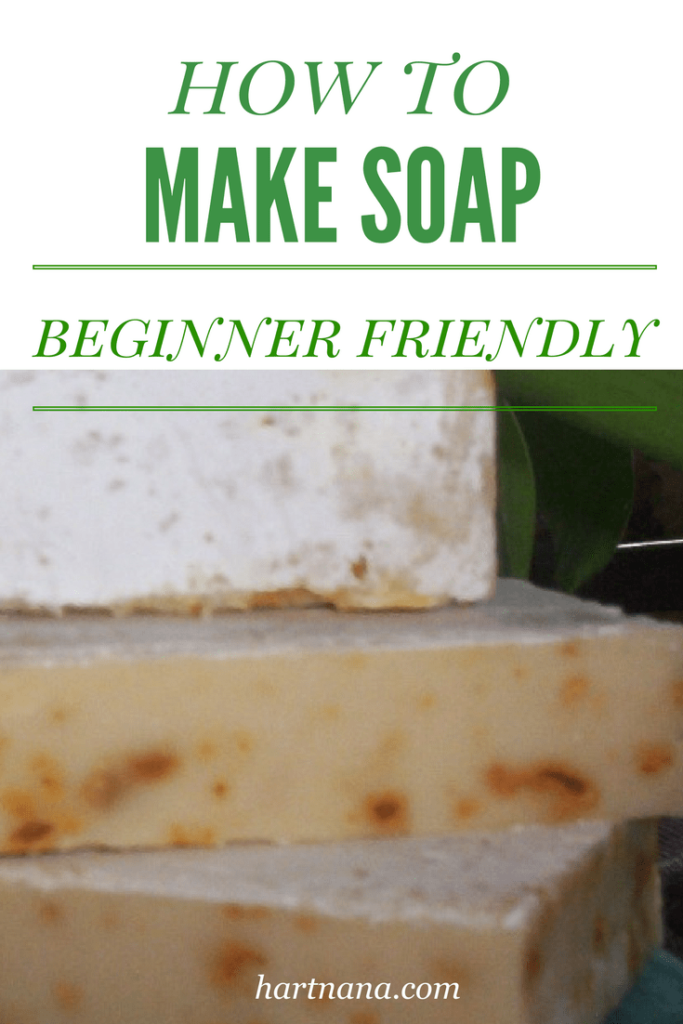
Here is the secret to getting cream colored goat’s milk soap
Rather than the orange/brown stuff that most beginners end up with. The reason goat’s milk soap turns brown is because the lye causes the milk solids to burn. The way around that problem is to mix the lye with water first, then mix the lye into the oils and then add the milk.
Another important point is that you want your lye solution and your oil to be about the same temperature and that temperature needs to be 100 degrees. It does make a difference.
I like to mix my lye solution over an ice bath. So I put the pitcher in a big bowl full of ice, mix the lye into the water s l o w l y so it doesn’t explode and then drop ice cubes down into the solution to get it to cool down quicker. I’m so not the patient type.
Here are the steps to the Homemade Goat Milk Soap Recipe for Beginners:
- Heat the coconut oil and shortening/lard until it melts in the big pot. Take it off the heat and add olive oil. Set aside to cool.
- Put on your safety glasses and gloves
- Put the pitcher in the ice bath add the water and then the lye to the water.
- Once both are the same temperature, 100 degrees, mix the lye into the oils (DO NOT DO THIS THE OTHER WAY AROUND )
- Add the milk.
- Use the stick blender to mix and blend. Do this in pulses of 20 seconds or you will burn out your blender. Between pulses stir with the blender.
- When the concoction traces it will look like vanilla pudding. Trace just means that it hold the shape of a swirl, like, as I said, vanilla pudding.
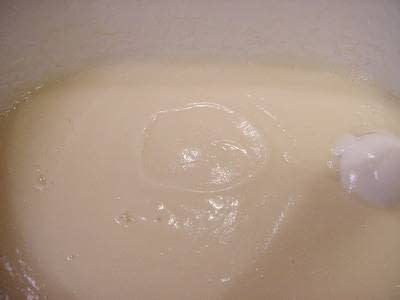
Once it begins to trace add your essential oil and extra stuff. I like to use lavender oil and lavender bits, but you can add almost anything. If you are planning to add oatmeal, you need to grind it up first. Take it from me, the whole oats things doesn’t work so well, I know, I’ve tried it.
Adding Stuff To Your Soap
When it comes to adding essential oils, I only add a few drops. For honey/oatmeal soap, I add about 1/4 cup of honey and a cup of oats. Also I have found that sandalwood oil can cause your soap to seize. (turns hard really fast) so go slow when adding that.
Make sure that you have lined your cardboard molds with wax paper before you start if you are planning to use cardboard molds. Pour your mixture into the mold after it has traced and you’ve added all your stuff and made sure it traced again.
Before you Cut Your Soap
Let the soap sit in the mold for 24 hours – it will harden up. You then want to dump it out and cut it into the shapes you want. Let it cure for at least 2-3 weeks before using. Enjoy!
The whole process shouldn’t take you more than maybe an hour from start to finish.
If you have questions ask them below, I follow this blog pretty closely and love to help new soap makers get started!
scaleClick HerelyeClick Hereenamel potClick Herehigh side enamel potClick HerethermometerClick Hereplastic pitcherClick Herewooden spponsClick Herepowdered goats milkClick Herecoconut oilClick Hereolive oilClick Hereessential oilsClick Heresoap moldClick Heresoap moldClick Heresoap moldClick Here
Don’t forget to grab your copy of The Soap Maker’s Journal so that you can keep your recipes in one place. Every time I make soap I always do something a little different. Recording the adjustments in this journal allows me to repeat success and avoid repeating unwanted results.
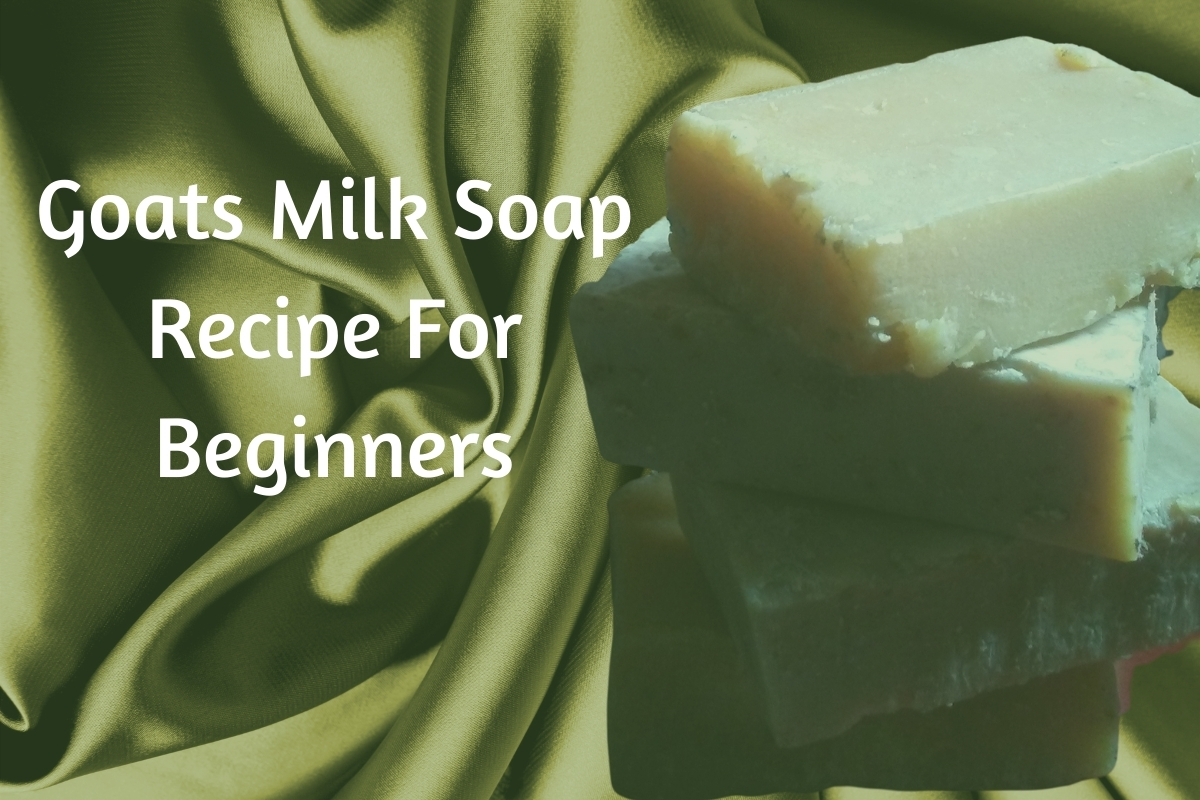














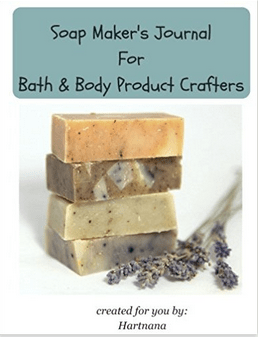

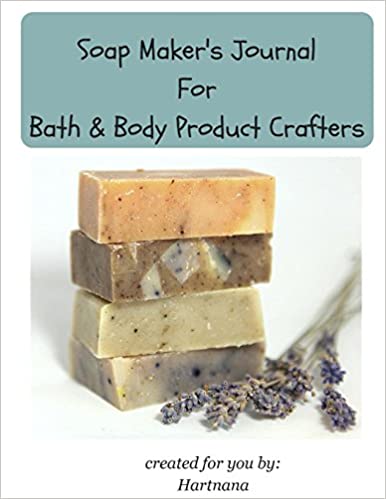
Does it matter what temp you store the soap bars at?
I just store mine at room temperature, which in my house is around 65-70ish. You might store in the basement if you have one – it is cooler in the summer.
Hi Nana this is my first time making goat soap and I was going to buy the rectangle soap mold that holds 6 bars at a time. how many molds should I buy so I don’t have left over soap going to waste?
If you are using the recipe here for easy goat milk soap I usually make it in campbells soup boxes (the kind of box you get when you pick up a flat of soup when you buy it in bulk) I just line it with wax paper. I think you will need 3 molds that hold 6 bars each to make this without having any left over. Without seeing the mold you are talking about it is kind of hard to judge. The recipe will make about 3lbs of soap. Hope that helps
I noticed a large canner as part of the equipment. By my calculations the recipe has approximately a total of 1 qt of liquids. Why such a large vessel for the ingredients? Also, I’m confused on step 4. When both are 100 degrees? What is both? The ice water bath and the water/lye? I have a tendency to over think things – bare with me. I have 14-16 gallons of goat milk in the freezer and need to do more than just cheese making. Thank you in advance for your assistance.
You are correct about the “over size” on the canner. I’m not a real detail oriented person for the most part. I like having deep sides so that I don’t splash the liquid outside the container, even accidentally. I’ve seen soap made in a large measuring glass using a microwave. If I tried that I’d for sure have caustic material spread between here and eternity. (you should see when I make frosting – powdered sugar and butter – everywhere LOL)
On step 4 the “both” refers to the oils and the water/lye material. It is easy to heat those oils up past 100 if, again, you are not a detail oriented person.
You can easily double or even quadruple this recipe, then you might pour off smaller quantities from the main pot before mixing in your essential oils & extra stuff. I would trace the soap poured off in the smaller container. It is hard to transfer the soap twice after tracing it. So use your stick blender to get the soap thickish then pour into smaller containers to add & trace then pour into your molds.
Hope this help – have fun!
Did you use distilled water for this recipe, I made it with regular tap water and didn’t realize most people use distilled for soapmaking. This was my first batch.
I don’t use distilled water when I make soap because the water we get out of the tap is well or spring water. (One of the percs of country living LOL)